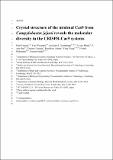Crystal Structure of the Minimal Cas9 from Campylobacter jejuni Reveals the Molecular Diversity in the CRISPR-Cas9 Systems
Author(s)
Yamada, Mari; Watanabe, Yuto; Hirano, Hisato; Ran, F. Ann; Nakane, Takanori; Ishitani, Ryuichiro; Nishimasu, Hiroshi; Nureki, Osamu; Gootenberg, Jonathan S; Zhang, Feng; ... Show more Show less
DownloadZhang6.pdf (8.683Mb)
PUBLISHER_CC
Publisher with Creative Commons License
Creative Commons Attribution
Terms of use
Metadata
Show full item recordAbstract
The RNA-guided endonuclease Cas9 generates a double-strand break at DNA target sites complementary to the guide RNA and has been harnessed for the development of a variety of new technologies, such as genome editing. Here, we report the crystal structures of Campylobacter jejuni Cas9 (CjCas9), one of the smallest Cas9 orthologs, in complex with an sgRNA and its target DNA. The structures provided insights into a minimal Cas9 scaffold and revealed the remarkable mechanistic diversity of the CRISPR-Cas9 systems. The CjCas9 guide RNA contains a triple-helix structure, which is distinct from known RNA triple helices, thereby expanding the natural repertoire of RNA triple helices. Furthermore, unlike the other Cas9 orthologs, CjCas9 contacts the nucleotide sequences in both the target and non-target DNA strands and recognizes the 5′-NNNVRYM-3′ as the protospacer-adjacent motif. Collectively, these findings improve our mechanistic understanding of the CRISPR-Cas9 systems and may facilitate Cas9 engineering. Keywords: CRISPR-Cas system; Cas9; protospacer adjacent motif; RNA triplex; crystal structure
Date issued
2017-03Department
Massachusetts Institute of Technology. Department of Biological Engineering; Massachusetts Institute of Technology. Department of Brain and Cognitive Sciences; McGovern Institute for Brain Research at MITJournal
Molecular Cell
Publisher
Elsevier
Citation
Yamada, Mari et al. “Crystal Structure of the Minimal Cas9 from Campylobacter Jejuni Reveals the Molecular Diversity in the CRISPR-Cas9 Systems.” Molecular Cell 65, 6 (March 2017): 1109–1121 © 2017 Elsevier Inc
Version: Author's final manuscript
ISSN
1097-2765
1097-4164